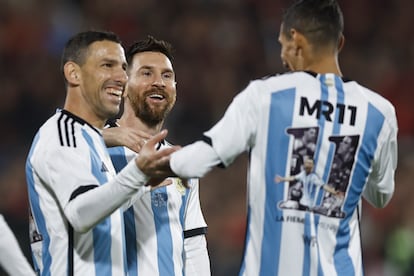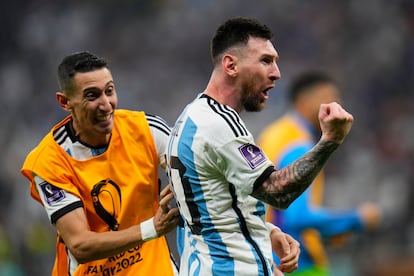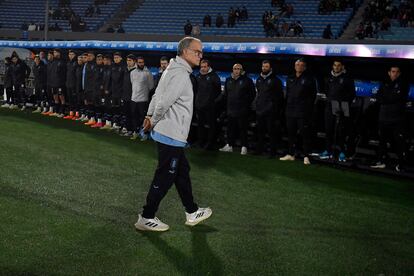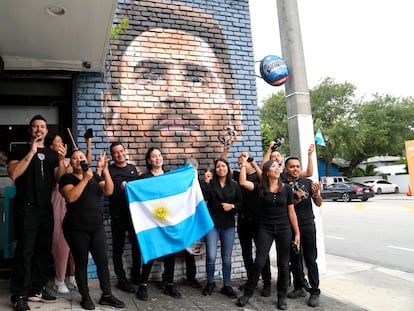Messi, Di María, Mascherano, Menotti, Bielsa: why Rosario is the capital of Argentinean soccer
Far from the spotlights of Buenos Aires, the provincial city is the largest quarry of stars for the World Cup winners

There are regions of the world that, either due to their geography, microclimate, diet, physical biotype, sports culture or labor traditions, are specialists in producing champions. Sometimes this formation is natural: the Rift Valley in East Africa is the homeland of the world’s best marathon runners. At other times it seems to be a statistical challenge: Spain’s smallest province, Guipúzcoa, will provide four of the English Premier League’s 20 managers next season. And in Argentina, the Qatar 2022 World Cup has revived the soccer phenomenon in Rosario, the so-called cradle of the national flag — it was raised there for the first time in 1812 — which is also considered a mecca for footballers and coaches: a Shangri-La of the beautiful game.
Six months ago, Argentina won the World Cup with three goals scored by Rosario-born in the final against France: two from Lionel Messi and one from Ángel Di María, the former a product of Newell’s and the other schooled at Rosario Central, the two clubs in the region that historically provide the biggest challenge to the traditional dominance of Buenos Aires.
Almost 300 kilometers (186 miles) north of the capital, Rosario — the country’s third largest metropolitan area with 1.3 million inhabitants — is also home to the largest number of the 69 players who made up the 1978, 1986 and 2022 World Cup-winning squads. Julio Libonatti, a Rosario native who played for Newell’s, was the first Argentinean footballer to be sold to a European team, in 1925, but the tradition also extends to coaches: César Luis Menotti, Argentina’s coach at the 1978 World Cup, and Marcelo Bielsa, now at the helm of Uruguay, are proud Rosario natives.

The list is incredible. Between the city and the larger metropolitan area, Gran Rosario, in recent years Javier Mascherano, Ángel Correa, Giovani Lo Celso, Maximiliano Rodríguez and Santiago Solari have all played for Argentina and some of Europe’s most famous teams. Since 2015, the Argentina national team has been managed exclusively by coaches from the area: Gerardo Martino; Edgardo Bauza, from Granadero Baigorria, six miles from Rosario; Jorge Sampaoli from Casilda, 31 miles away, and, of course, the 2022 World Cup-winning coach Lionel Scaloni, who hails from from Pujato, 15 miles from Rosario.
Many of them gathered on Saturday night at Newell’s Estadio Marcelo Bielsa for a farewell match in honor of Maxi Rodríguez, who came through the ranks at the club. Among those taking part were Messi, Scaloni, Martino, and Di María. The crowd of 45,000 people sang for Messi to finish his career at his boyhood team, in the red and black half of the city.
Meanwhile, on June 29, a documentary will premiere in Buenos Aires, which seeks to answer the question as to why so many great Argentinean players emerge from Rosario. Titled Pelotero del mundo (or, Ball player of the world), Damián Finvarb and Ariel Borenstein’s film focuses on the training process of young players in neighborhood teams. The destiny of some of them, inevitably, will be Europe. “Rosario is also the port through which Argentina exports soybeans and other raw materials. We wanted to show how the soccer leadership is not so different from that of the country,” says Borenstein.
Raised to cult status by Jorge Griffa in the 1980s and Jorge Solari in the 1990s, both trainers of hundreds of boys, some of whom traveled from other parts of the country to finish their training in Rosario — including Gabriel Batistuta, Mauricio Pochettino, Edgardo Bauza and Martín Demichelis — the phenomenon of youth soccer in the city is impressive: eight separate leagues are contested simultaneously.
The only one affiliated to the Argentine Football Association is the Asociación Rosarina, which, in its lower divisions alone — including men’s, women’s and futsal tournaments — has 92 affiliated clubs, 985 teams and 37,000 players. Outside the official organization there are dozens of other small institutions — for example Grandoli, where Messi started playing in his local neighborhood before moving to Newell’s — which are affiliated to the other six children’s soccer leagues in Rosario, some more competitive and others of a more friendly nature.
In his book Rosario, cuna de cracks (or, Rosario, cradle of the stars), journalist Nicolás Galliari suggests three reasons for this phenomenon: “The first is the competition, which the kids get used to from the age of four among the hundreds of clubs in the city. Then, from the 1960s onwards, there were always great coaches, such as Griffa, Bielsa, Solari, Miguel Ignomiriello, Carlos Timoteo Griguol and Ángel Tulio Zoff. And thirdly, in this area of the country there are boys who are very well prepared physically, well fed. The clubs then improve on that, but they have a base to work on. And to all that, we have to add the passion the city has for soccer.”

Beginning in the 1980s, scouting changed in Rosario. The coaches at the Renato Cesarini club, which is dedicated solely to the training of youngsters — the academy has a total of 700 players starting from the age of four — began to travel around the region in search of promising local talent. Previously, the system had worked in reverse, with the clubs waiting for the kids to come to them for tryouts. The method was perfected by Bielsa in the Newell’s youth teams in the early 1990s, when he traveled all over Argentina in his car in search of future stars. Today, River Plate, Boca Juniors and the rest of the Argentinean clubs do the same thing.
Within this culture, Rosario’s best soccer storyteller, Roberto Fontanarrosa, and its greatest myth, Tomás Felipe “El Trinche” Carlovich, who spent most of his career with Central Córdoba, the city’s third team and who was considered the best unknown soccer player in the world, are also part of the fabric of the city’s sporting history. “Soccer in Rosario is an inconceivable cultural fact. There is a passion from which it is very difficult to retire. In Buenos Aires, soccer is not as set in its ways and ingrained as in Rosario, and that requires a different communication; it is very formative, it generates daily debate. Besides, we played better than everyone because the English didn’t come here; the Scots did and they passed the ball more,” Menotti told Tiempo Argentino in 2017.
Described in police reports 100 years ago as “the Argentine Chicago” and reconverted in the 21st century as the largest drug-trafficking headquarters in the country — which explains why the homicide rate is four times higher than in the rest of Argentina — a phrase from Pelotero del mundo sums up one of the greatest prides of Messi’s city: “In this soil, there is soccer.” And the tradition remains strong: last Monday, in Argentina’s 2-0 victory against Indonesia in a friendly in Jakarta, an 18-year-old youngster trained at Rosario Central and now at Premier League side Brighton made his debut for the national team. His name is Facundo Buonanotte and he was born in Pérez, in the metropolitan area of Rosario, a city that should be called Soccer.
Sign up for our weekly newsletter to get more English-language news coverage from EL PAÍS USA Edition
Tu suscripción se está usando en otro dispositivo
¿Quieres añadir otro usuario a tu suscripción?
Si continúas leyendo en este dispositivo, no se podrá leer en el otro.
FlechaTu suscripción se está usando en otro dispositivo y solo puedes acceder a EL PAÍS desde un dispositivo a la vez.
Si quieres compartir tu cuenta, cambia tu suscripción a la modalidad Premium, así podrás añadir otro usuario. Cada uno accederá con su propia cuenta de email, lo que os permitirá personalizar vuestra experiencia en EL PAÍS.
¿Tienes una suscripción de empresa? Accede aquí para contratar más cuentas.
En el caso de no saber quién está usando tu cuenta, te recomendamos cambiar tu contraseña aquí.
Si decides continuar compartiendo tu cuenta, este mensaje se mostrará en tu dispositivo y en el de la otra persona que está usando tu cuenta de forma indefinida, afectando a tu experiencia de lectura. Puedes consultar aquí los términos y condiciones de la suscripción digital.
More information
Archived In
Últimas noticias
Welcome to the post-religion era: The idea of Christianity as the absolute truth has become obsolete
‘I thought you would like it’: The risky sexual practice popularized by TV shows and TikTok
The digitalization of tourism: ‘They promise experiences and gave us the worst possible one’
Mexican peso defies uncertainty with forecasts of a new period of stability in 2026
Most viewed
- Sinaloa Cartel war is taking its toll on Los Chapitos
- Reinhard Genzel, Nobel laureate in physics: ‘One-minute videos will never give you the truth’
- Oona Chaplin: ‘I told James Cameron that I was living in a treehouse and starting a permaculture project with a friend’
- Why the price of coffee has skyrocketed: from Brazilian plantations to specialty coffee houses
- Silver prices are going crazy: This is what’s fueling the rally










































